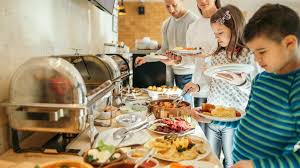In pre-pandemic times, Rick Bell had the breakfast routine down at Engadine Inn and Cabins near Asheville, N.C., where he is an owner and cook.
The service started at 9 a.m.
First course: a fruit-based dish.
Second: traditional hot breakfast, either sweet or savory depending on the day.
Plates went out one at a time to guests in the dining room, along with juice and coffee. Mealtime and tables are being spread out, and porches are open for breakfast.
And instead of making several visits to a table, a server is leaving all the plates, pots, and cups at once to avoid too much interaction.
“The meal is delivered hopefully before you arrive, and then you’re on your own unless you need something,” Bell said.
Like hoteliers all over the world, Bell is having to reconsider once-standard morning meal plans to accommodate new health regulations, employee safety, and customer concerns as the coronavirus changes the way people travel and dine.
For the many hotel brands that have elevated breakfast as a key part of their offering, the adjustment is especially important.
Anthony Melchiorri, a hospitality consultant and host of “Hotel Impossible” on the Travel Channel, said breakfast has been a hot topic as hotels consider changes forced by the coronavirus.
“It’s coming up across the brands”, he said.
“There are so many ways to make it work, I don’t think you need to take it away”.
Americans aren’t yet returning in droves to hotels. According to data from travel research firm STR, U.S. hotel occupancy reached just over 39% between May 31 and June 6, a slight uptick from the previous week but a steep drop from the same time a year earlier.
Still, when guests do get back to hotels, they want to find their favorite amenities.
“They still want their breakfast, and you’ve got to be able to provide the breakfast”, Melchiorri said.
He said hotels have plenty of options, including extending hours, limiting capacity, asking guests to make reservations at staggered times, and having staff dish out food that customers might have retrieved themselves.
At Hyatt, guests are able to use the company’s app to see menus, order food to pick up, and pay for their meals. Restaurants offering breakfast service have shifted from self-service buffets to a-la-carte menus or made-to-order options. Individually pre-packaged items may also be available for guests to grab on-the-go.
Industry giant Marriott said in a statement that the company was looking at spacing out furniture in food and beverage areas, adding new signage, updating the way food is prepared and distributed, and using contactless room service, among other measures.
Hilton, whose Embassy Suites and Hampton Inn brands have developed a fan base thanks to their breakfast options — including make-your-own waffles — is moving away from buffets in favor of grab-and-go meals.
Where room service is available, it will arrive in a shopping bag instead of a rolling cart, and the delivery will be contact-free.
On the Internet, people wonder: “Can someone explain to me what is the point of going to a hotel if there is no breakfast buffet?!”
According to a 2018 news release, people eat nearly 27 million waffles and use 627,000 gallons of syrup each year at Hampton hotels in the United States.
The competition over breakfast foods inspired Hampton’s make-your-own waffle option as a way to help the brand stand out, according to a history provided by Hilton.
Challenged to find “cool, different features, a team considered and rejected items such as breakfast on a stick and plain pre-made waffles before deciding on fresh waffles.”
“We are working to return to what our customers know and love as quickly as possible, but are doing so cautiously always with their safety, and that of our team members, in mind,” said the main hotel-manager.



